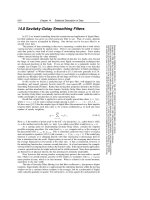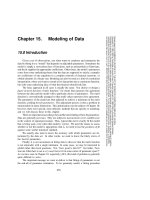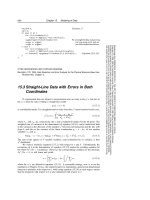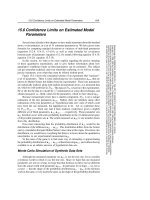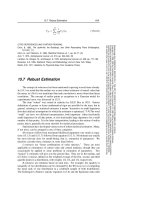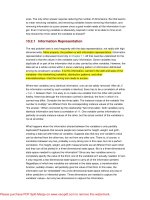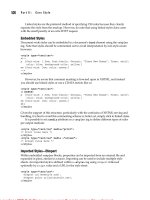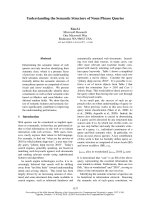THE FRACTAL STRUCTURE OF DATA REFERENCE- P12 ppt
Bạn đang xem bản rút gọn của tài liệu. Xem và tải ngay bản đầy đủ của tài liệu tại đây (126.94 KB, 5 trang )
Hierarchical Reuse Daemon 4 1
Figure 2.2.
per second, with v = 0.40 (corresponding to θ = 0.25).
Distribution of interarrival times for a synthetic application running at one request
Figure 2.3.
per second, with v = 0.34 (corresponding to θ = 0.35).
Distribution of interarrival times for a synthetic application running at one request
42 THE FRACTAL STRUCTURE OF DATA REFERENCE
A general
-
purpose technique exists for generating synthetic patterns of ref
-
erence, which is also capable of producing references that conform to the
hierarchical reuse model. This technique is based upon the concept of stack
distance, or the depth at which previously referenced data items appear in the
LRU list [8, 21]. The idea is to build a history of previous references (organized
in the form of an
LRU list), and index into it using a random pointer that obeys
a specified probability distribution. Due to the ability to manipulate the proba
-
bility distribution ofpointer values, this technique has much greater generality
than the toy application proposed in the present chapter. The memory and
processing requirements implied by maintaining a large, randomly accessed
LRU list of previous references, however, make this approach problematic in a
real
-
time benchmark driver.
In the same paper of his just referenced in the previous paragraph, Thiébaut
also touches upon the possibility of producing synthetic references by perform
-
ing a random walk [21]. The form that he suggests for the random walk is
based upon the fractal relationships among successive reference locations, as
observed by himself and others. It is not clear from the material presented in
the paper, however, whether or not Thiébaut actually attempted to apply this
idea, or what results he might have obtained.
Returning to the context of the hierarchical reuse model, we have shown that
its behavior can, in fact, be produced by a specific form of random walk. The
proposed random walk technique has the important advantage that there is no
need to maintain a reference history. In addition, it can be incorporated into a
variety of individual “daemons”, large numbers of which can run concurrently
and independently. This type of benchmark structure is attractive, in that
it mirrors, at a high level, the behavior of real applications in a production
environment.
Chapter 3
USE OF MEMORY BY MULTIPLE WORKLOADS
The opening chapter of the book urges the system administrator responsible
for storage performance to keep an eye on the average residency time currently
being delivered to applications. In an installationthat must meet high standards
of storage performance, however, the strategy suggested by this advice may
be too passive. To take a proactive role in managing application performance,
it is necessary for the storage administrator to be able to examine, not just
cache residency times, but also the amounts of cache memory used by each
application. This information, for example, makes it possible to ensure that
the cache size of a new storage control is adequate to support the applications
planned for it. The purpose of the present chapter is to develop a simple
and powerful “back
-
of
-
the
-
envelope” calculation of cache use by individual
applications.
The proposed technique is based on a key simplifying assumption, which
we shall adopt as a
Working hypothesis: Whether an application is by itself in a cache or
shares the cache, its hit ratio can be projected as a function of the average
cache residency time for the cache as a whole. Except for this relationship, its
performance can be projected independently of any other pools served by the
cache.
In the first subsection of the chapter, we examine this hypothesis more
closely. It leads directly to the needed analysis of cache use by individual
applications.
To motivate the hypothesis just stated, recall that all workloads sharing a
cache share the same, common single
-
reference residency time τ. The effect
of the working hypothesis is to proceed as though the same were true, not just
for the single
-
reference residency time, but for the average residency time as
well.
44
THE FRACTAL STRUCTURE OF DATA REFERENCE
In the usual process for cache capacity planning, the bottom line is to
develop overall requirements for cache memory, and overall expectations for
the corresponding hit ratio. The practical usefulness of the proposed working
hypothesis thus rests on its ability to yield accurate hit ratio estimates for the
configured cache as a whole.
The final subsectionofthe chapter compares overall cache hit ratio estimates,
obtained using the working hypothesis, with more precise estimates that might
have been obtained using the hierarchical reuse model. We show that, despite
variations in residency time among applications, the working hypothesis yields
a sound first
-
order estimate of the overall hit ratio. Thus, although the working
hypothesis is admittedly a simplifying approximation, strong grounds can be
offered upon which to justify it.
1. CACHE USE BY APPLICATION
a cache. Then we may conclude, as a direct application of(1.18), that
Suppose that some identified application i comprises the entire workload on
(3.1)
where the subscripts i denote quantities that refer specifically to application i.
The central consequence of the working hypothesis just introduced is that, as
a simplifying approximation, we choose to proceed as though the same result
were also true in a cache shared by a mix of applications.
For example, suppose that it is desired to configure cache memory for a
new
OS/390 storage subsystem that will be used to contain a mix of three
applications: a point of sale (
POS) application implemented with CICS/VSAM,
an Enterprise Resource Planning (ERP) database implemented with DB2, and
storage for 20 application developers running on
TSO. Then, as a starting point,
we can examine the current requirements of the same applications.
Tables 3.1–3.3 present a set of hypothetical data and analysis that could be
developed using standard performance reports. Data assembled for this purpose
should normally be obtained at times that represent peak
-
load conditions.
In the example of the figures, the
ERP and TSO applications both currently
share a single cache (belonging to the storage subsystem with volume addresses
starting at 1F00); the
POS application uses a different cache (belonging to
the storage subsystem with volume addresses starting at 0880). The average
residency time for each cache is calculated by applying (1.15) to the total cache
workload, as presented by Table 3.1. For example, the average residency time
for the cache belonging to the storage subsystem with volume addresses starting
at 0880 is calculated as 1024 / (.04 x 425 x .23) = 262 seconds.
We proceed by assuming that this average residency time applies both to the
cache as a whole (Table 3.1) as well as to each application currently contained
in it (Table 3.2). Based upon this assumption, we may then apply (1.18) to
Use of Memory by Multiple Workloads
45
calculate the current cache use of each application. For example, the current
cache use of the
ERP application is calculated as .04 x 490 x .36 x 197 = 1390
megabytes. The total current cache use of the three applications is 1891
megabytes; their aggregate hit ratio (average hit ratio, weighted by I/O rate) is
calculated as (230 x .81 + 490 x .64 + 50 x .89) / 770 = .71.
We must now decide upon an objective for the average residency time of
the target system.
To ensure that all applications experience equal or better
performance, a reasonable choice is to adopt the longest average residency time
among the three applications (262 seconds) as the objective. Table 3.3 presents
the estimated performance of the three applications, assuming this objective for
Storage Subsystem Cache
Stage
I/O Total
Average
(Hex) (MB)
(MB)
per s Ratio
Time (s)
0880
1024 .04 425 .77 262
1F00 2048
.04
840 .69
197
Starting Address Size Size Rate Hit Residency
Table 3.1. Cache planningexample: current storage subsystems.
Application Storage Subsystem Average
Stage I/O Total Cache
Starting Address Residency
Size Rate
Hit Use
(Hex)
Time (s)
(MB) per s Ratio (MB)
POS
0880 262 .04 230 .81 458
ERP 1F00
197 .04 490 .64
1390
TSO
1F00 197 .04 50 .89 43
All 770 .71 1891
Table 3.2. Cache planning example: three applications contained in current storage.
Application Storage Subsystem Average
Stage I/O
Total Cache
Starting Address Residency
Size Rate
Hit Use
(Hex)
Time (s)
(MB) per s Ratio (MB)
POS New
262 .04 230 .81
458
ERP New 262 .04 490 .66
1746
TSO
New 262 .04 50 .90 52
All New 262 .04 770 .72 2256
Table 3.3. Cache planning example: target environment for the same three applications.
